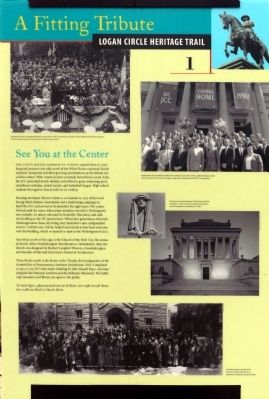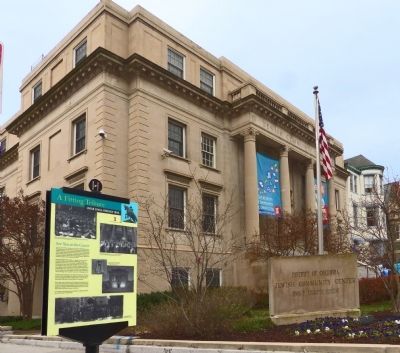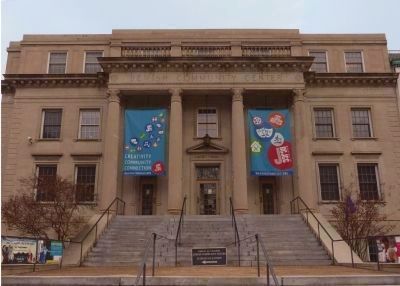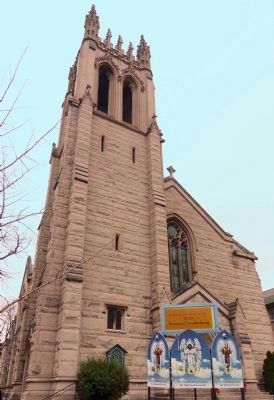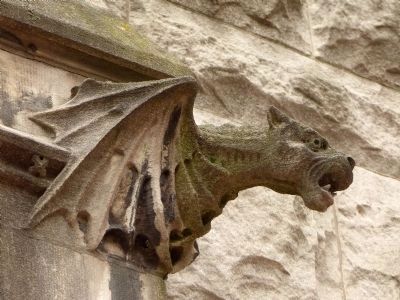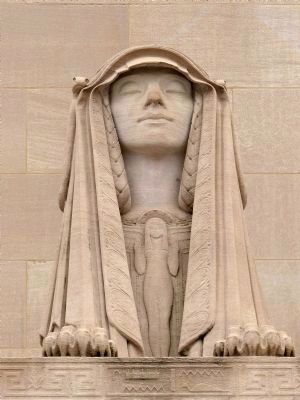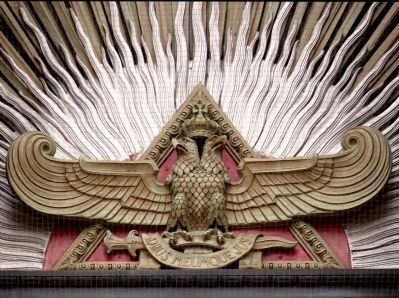Dupont Circle in Northwest Washington in Washington, District of Columbia — The American Northeast (Mid-Atlantic)
See You at the Center
A Fitting Tribute
— Logan Circle Heritage Trail —
The City's Jewish Community Center opened here in 1926. Its grand presence one mile north of the White House expressed Jewish residents' prosperity and their growing contributions to the federal city and the nation. With American Jews routinely barred from social clubs, the JCC promoted Jewish identity and offered a gym, swimming pool, symphony orchestra, choral society, and basketball league. High school students thronged to dances held on the rooftop.
Housing developer Morris Cafritz, a co-founder in 1912 of the local Young Men's Hebrew Association, led a fundraising campaign to build the JCC and served as its president for eight years. The center thrived until the 1950s, when many members moved to Washington's new suburbs. In 1969 it relocated to Rockville, Maryland and sold this building to the DC Government. When later generations of Jewish Washingtonians close city living, they launched a new independent DCJCC. Cafritz' son, Calvin, helped raise funds to buy back and renovate the building, which reopened in 1996 as the Washington DCJCC.
One block north of this sign is the Church of the Holy City, the national church of the Swedenborgian denomination. Dedicated in 1896, the church was designed by Herbert Langford Warren, a Swedenborgian and founder of Harvard University's School of Architecture.
Three blocks north is the House of the Temple, headquarters of the Scottish Rite of Freemasonry, Southern Jurisdiction, USA. Completed in 1915, it was DC's first major building by John Russell Pope, who later designed the National Archives and the Jefferson Memorial. The building's museums and library are open to the public.
Erected 2012 by Cultural Tourism DC. (Marker Number 1.)
Topics and series. This historical marker is listed in these topic lists: Architecture • Charity & Public Work • Churches & Religion • Fraternal or Sororal Organizations. In addition, it is included in the Logan Circle Heritage Trail series list. A significant historical year for this entry is 1926.
Location. 38° 54.666′ N, 77° 2.186′ W. Marker is in Northwest Washington in Washington, District of Columbia. It is in Dupont Circle. Marker is at the intersection of 16th Street Northwest and Q Street Northwest, on the right when traveling north on 16th Street Northwest. Touch for map. Marker is at or near this postal address: 1600 16 St Northwest, Washington DC 20009, United States of America. Touch for directions.
Other nearby markers. At least 8 other markers are within walking distance of this marker. Foundry United Methodist Church Stormwater Features (about 300 feet away, measured in a direct line); The Stonesdale (about 300 feet away); The Cairo (about 300 feet away); Administration Building, Carnegie Institution of Washington
Credits. This page was last revised on January 30, 2023. It was originally submitted on January 2, 2015, by Allen C. Browne of Silver Spring, Maryland. This page has been viewed 661 times since then and 52 times this year. Last updated on March 8, 2019, by Devry Becker Jones of Washington, District of Columbia. Photos: 1. submitted on January 2, 2015, by Allen C. Browne of Silver Spring, Maryland. 2. submitted on December 2, 2017, by Devry Becker Jones of Washington, District of Columbia. 3, 4, 5, 6, 7, 8, 9. submitted on January 2, 2015, by Allen C. Browne of Silver Spring, Maryland. • Bill Pfingsten was the editor who published this page.
